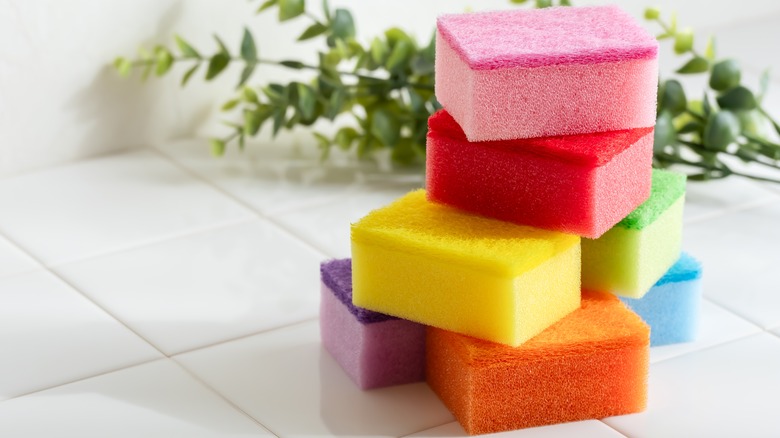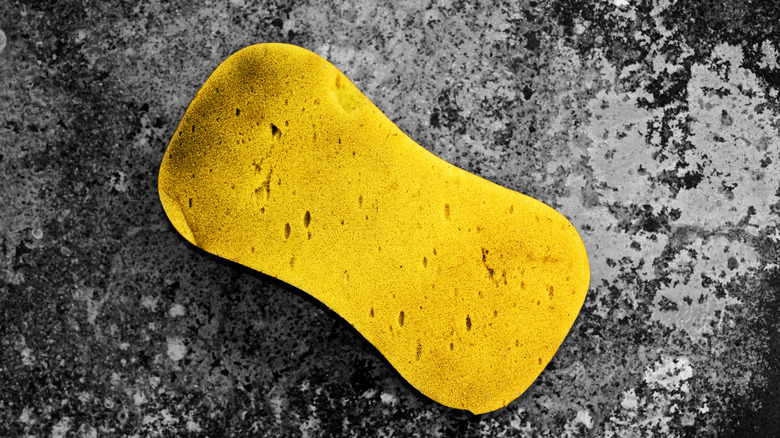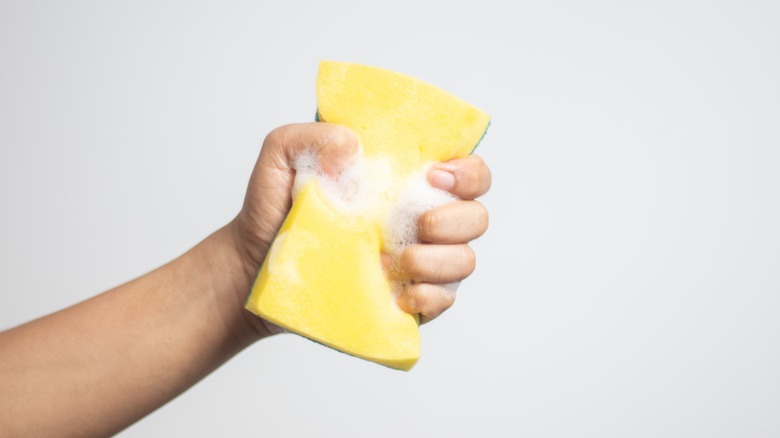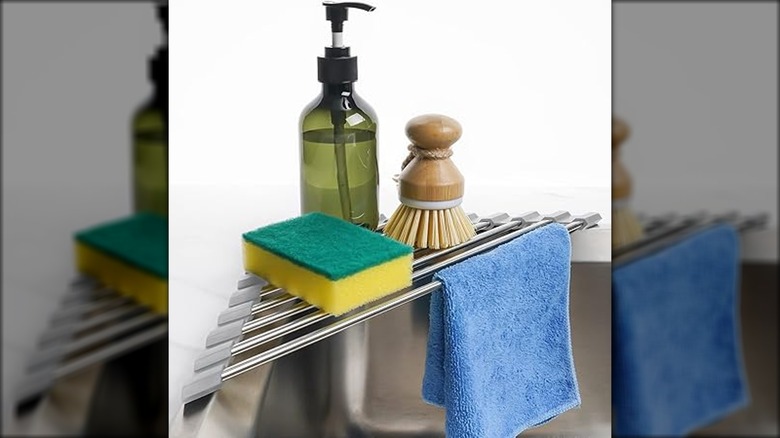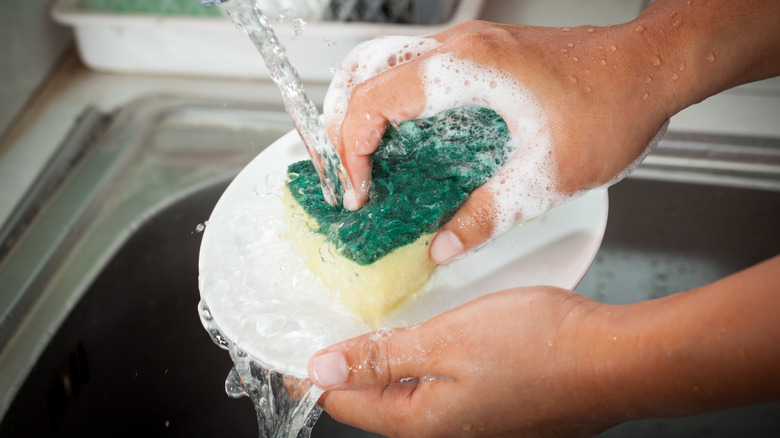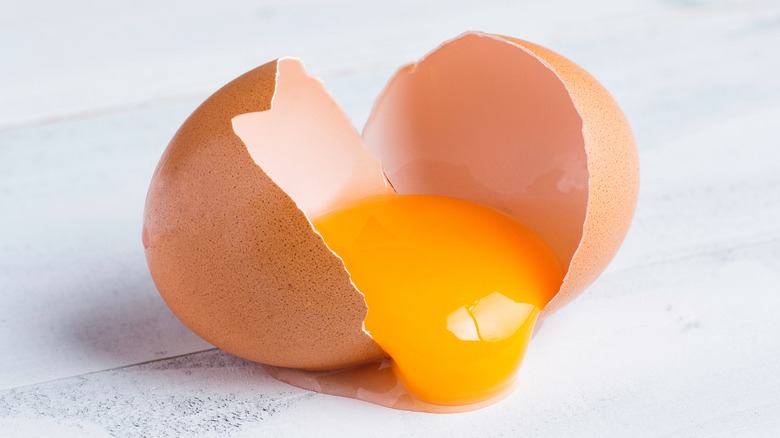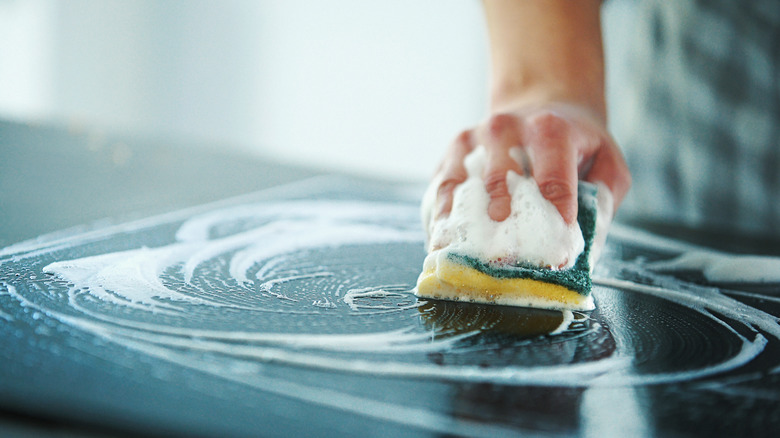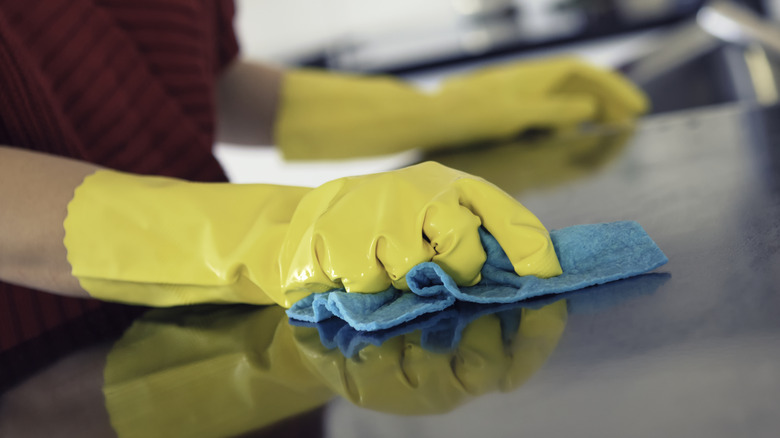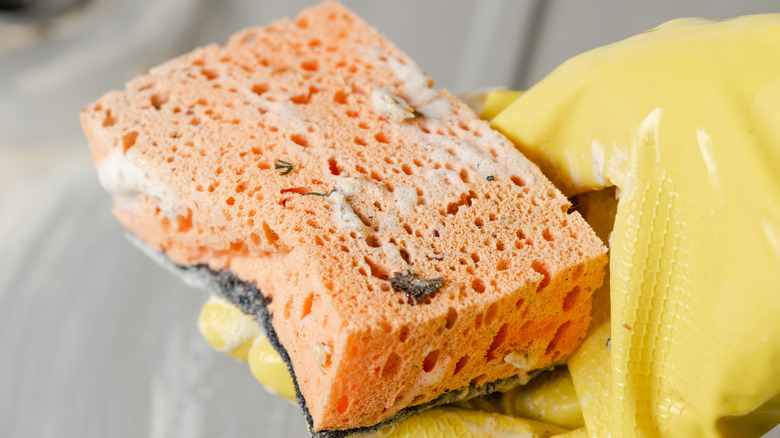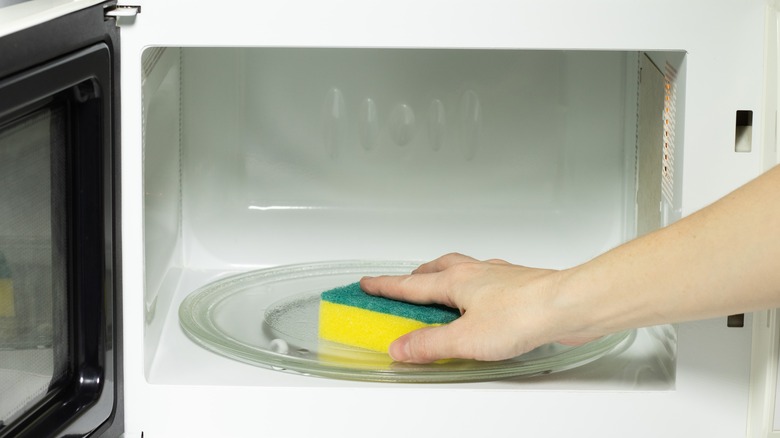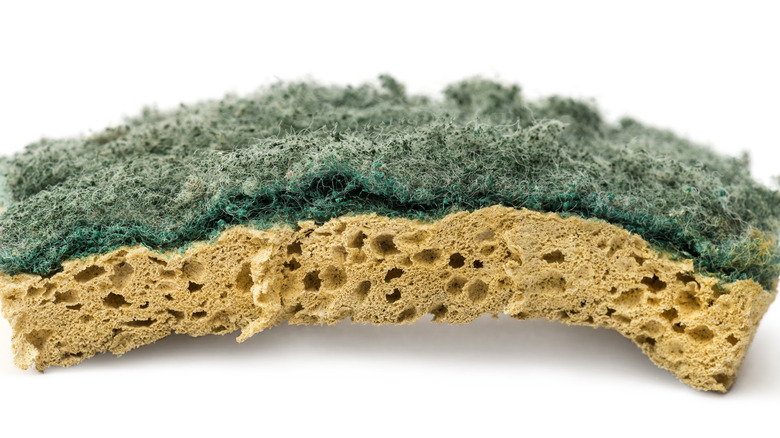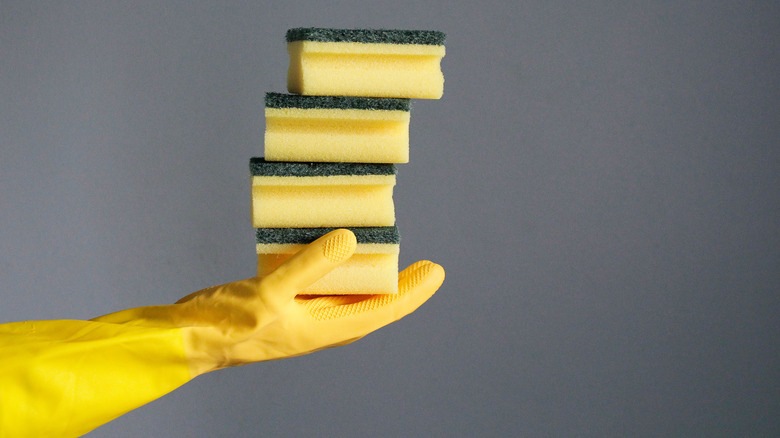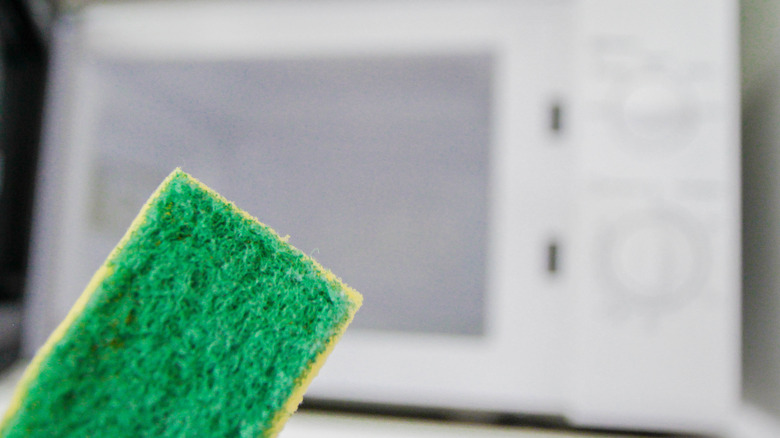Mistakes Everyone Makes With Their Kitchen Sponge, According To Scientists
We may receive a commission on purchases made from links.
When it comes to using sponges in our kitchen, most of us have been making mistakes with them all our lives. While the mistakes you make with sponges may not be a big deal most of the time, not being diligent with them has the potential to make you and your family sick if the wrong pathogens are present.
To bring you the most accurate information for how to use sponges in your kitchen, we turned to two experts on kitchen food safety topics. One person who provided insight for us is Dr. Manan Sharma, a USDA Agricultural Research Service (ARS) research microbiologist. The other is Dr. Kristen Gibson, a professor and the director for the Center for Food Safety at the University of Arkansas. We wanted to give you an image of how scientists who study the types of microorganisms that you might find in your kitchen apply the knowledge in real life. So, we asked both for their expertise and about their personal routines and practices when it comes to using sponges in the kitchen.
We hope you'll come away with not only new insight into what might be living in your sponges but also what practices you have with them that might not be very safe. Armed with sound scientific information, you can also think about instituting a safer cleaning regimen for your kitchen and dishes.
Not realizing that sponges are microbial breeding grounds
Sponges are dirtier than you might think and likely one of the grossest things in your kitchen. Dr. Manan Sharma said, "The biggest mistake would be just to ignore them and assume they are clean and cannot spread spoilage or pathogenic bacteria in a kitchen. They are like any other utensil in a kitchen, that requires cleaning or washing." So, let us look at how dirty sponges really are.
The fact that sponges are porous and full of lots of nooks and crannies gives them plenty of places for bacteria to hide and thrive. Combine that type of environment with getting and staying wet, and suddenly you've created the perfect place for a whole community of microorganisms to live and multiply. For example, a 2017 study in Scientific Reports showed that the kitchen sponges they were studying contained over a hundred different species of bacteria. It mentioned that the number of microorganisms living in kitchens tends to outnumber those living in toilets. Of those microorganisms in the kitchen, a large proportion of them are hiding out in your kitchen sponges.
The study also cited numerous other studies that uncovered some concerning bacteria living in sponges. These include ones like E. coli, salmonella, staphylococcus, campylobacter, and Enterobacter cloacae, which can all cause a wide range of potentially dangerous physical symptoms and diseases.
Keeping sponges too wet
When we talked with Dr. Kristen Gibson, she said one of the biggest mistakes people make with sponges is "keeping them wet or really damp when not in use." So, be sure to wring out your sponge next time you use it.
Wet sponges are the perfect medium to grow microorganisms. Dr. Gibson pointed out something you may have never thought about when it comes to your kitchen sponge. She said the "majority of bacteria need moisture to maintain viability and/or grow ... and if nutrients are available, then the available water allows them to utilize those nutrients. For example, water activity in food products is one of the many ways we control the potential for bacterial growth in foods." So, every time you leave your sponge sopping wet, you're essentially helping your sponge's microorganism colony grow even larger.
Not only is moisture an issue, but your kitchen's temperature makes a difference, too. Dr. Manan Sharma explained that "[m]ost bacteria that cause foodborne illness require moisture to grow and can survive for longer durations when moisture levels are high. Leaving a wet sponge at the right temperature can provide conditions where foodborne pathogens can grow, or at least survive for longer periods of time." According to the USDA, the perfect temperature range for bacteria to grow (known as the "danger zone") is between 40 and 140 degrees Fahrenheit. Unless your power is out in the middle of winter, your kitchen temperature falls into this range.
Storing sponges improperly
Once you realize what a bad idea it is to keep your sponge wet, you may realize that you need to rethink how you're storing your sponges. If you're just throwing them in the sink or somewhere else where they can't dry out between uses, you're helping to add to the community of microbes living in your sponge.
Both Dr. Manan Sharma and Dr. Kristen Gibson suggested storing your sponges in a place where they can dry completely before using them again. Dr. Sharma said, "Storing sponges dry will definitely allow you to use them for longer periods of time and also prevent the likelihood that bacteria (including foodborne pathogens) can survive and grow in the sponge." Dr. Gibson said, "I try to squeeze out all of the excess water and then set it on a dry surface. The sponge holders can be good, but then those can also get gross and trap moisture." Thus, something that allows air flow on all four sides so that it can dry evenly seems ideal for keeping a sponge as dry as possible between uses.
A 2022 study in the Journal of Applied Microbiology indicates that drying a sponge can reduce the amount of salmonella present on it. However, the key to storing them properly is to keep them as dry as possible to prevent bacteria from growing to dangerous levels in wet conditions.
Not avoiding cross-contamination
Everything you touch in the kitchen that has germs provides the potential for cross-contamination, including sponges. Dr. Manan Sharma explained that "just like unwashed and uncleaned kitchen utensils, sponges can cross contaminate dishes, utensils ... if they are not properly maintained." There's also the potential for you to transfer germs from a sponge to other places as well.
Consider all the things you touch in the kitchen from food to surfaces. If you've been using a dirty sponge, there's a chance of transferring bacteria from the sponge to your hands and to other surfaces like countertops and to your food. According to the USDA, even if you deep-clean your sponges with some of the methods we will discuss later, they still have the potential to cross contaminate anything they come in contact with both directly or indirectly.
To avoid cross-contamination, Dr. Kristen Gibson also points out that she never uses her kitchen sponges in other places in the house. She said that she has a "kitchen sponge for washing dishes and then there are other cleaning sponges for ... the bathroom sink and such."
Using sponges to clean raw meat or poultry juices
One thing you've likely been doing in your kitchen that you shouldn't be doing is using your sponge to clean surfaces with meat or poultry juices on them. In fact, Dr. Kristen Gibson said, "The only time I might be particularly concerned [about cross-contamination] is if the sponge was used directly on raw poultry or meat products or to clean up the juices that may have spilled from those products." The reason is that it increases the chance of your sponge collecting and growing colonies of pathogens that are more common in meat and poultry products, such as E. coli, salmonella, and others.
To prevent cross-contamination from possible pathogens in meat, Dr. Gibson said that she would "never use a reusable sponge directly on the raw meat/poultry product." So, that means not using a sponge to wash dishes, utensils, countertops, or cutting boards that are covered in meat or poultry juices, including raw eggs.
So, what should you do instead? Dr. Gibson said, "[I]f prepping raw meat/poultry in the kitchen, then I would clean up with a paper towel and a disinfecting spray, not a sponge." So, now you realize that a sponge isn't appropriate for every kitchen cleaning project. Instead, rather than hand wash meat-juice-covered dishes, you might stick them in the dishwasher or use something to wash them that's easier to disinfect, like a dishcloth (more about that later).
Using sponges on countertops
Something else that you've likely been doing wrong with your sponge is using it to clean food spills on your countertops. In fact, many of us probably use sponges on our countertops more than any other place since our dishwashers tend to do most of the other work for us. Now that you know how much your sponge harbors microbes and has the potential to spread pathogens, you can imagine why using a sponge on your countertop might be a bad idea. Instead of wiping germs away, you're more likely to spread them around the kitchen with a sponge.
We like Dr. Kristen Gibson's routine when it comes to countertops. She told us, "I personally only use a kitchen sponge to wash dishes. Even when I wipe down a table or surface, I use a multipurpose cleaner (or disinfectant, depending on what I am cleaning up) and a kitchen towel. I will then immediately put the kitchen towel in the laundry room for cleaning. I think we have like 50 kitchen towels in my house!" Paper towels and food-grade disinfecting wipes are also good candidates for wiping up countertop spills.
Not considering other cleaning methods for some surfaces
Now that you know that it's a bad idea to use sponges on meat and poultry juices and on countertops, you're going to need to come up with an alternative to sponges for those kitchen cleanups. Luckily, Dr. Kristen Gibson had some good ideas for sponge alternatives.
She said, "Based [on] some of the work out there and that I have done on various cleaning cloths, microfiber may be a good/better option ... And then these can also be laundered." She also suggested machine-washable sponge-like Swedish dishcloths as an option. We think they're one of many cleaning products you should have in your kitchen if you don't already.
When we asked her about how well laundering gets rid of microorganisms and pathogens, she said, "There is quite a bit of research on the effect of laundering on pathogens especially in clinical settings. Most bacteria will die very quickly in the washing environment due to water temp if hot or just the detergent itself and then the drying heat will certainly impact microbial survival." So, if you spend a lot of time in your kitchen, you might want to invest in some laundry-washable options to go along with your sponges. Having a large number of cloths and a dedicated laundry basket for soiled dish cloths like Dr. Gibson has can help ensure that you're not cross-contaminating your kitchen with an old, dirty dishcloth.
Using sponges for too long before cleaning them
When it comes to how often to clean your sponge, Dr. Manan Sharma said, "It truly depends how much an individual uses their kitchen and washes their dishes, pans, utensils ... But constantly disinfecting them will extend their utility and keep them cleaning dishes and pots and pans."
There's not one rule to fit everyone's kitchen sponge usage. However, Dr. Sharma said that "if you cook every day and use sponges to clean, you'll need to clean / disinfect them more regularly."
A 2020 study in the Microorganisms Journal had participants sanitize polyurethane sponges in the microwave two or three times a week, which resulted in fewer overall microorganisms living on the sponge. Some people take an even more conservative approach on how often to clean sponges, opting to clean them between each use. It certainly doesn't hurt to finish up your dishes with your sponge and then set it aside to disinfect without using it again until it has been disinfected.
Not cleaning them properly
Not every way that you can clean a sponge is equal. If you've been just rinsing them out with soap and water and calling it done, you're keeping them dirtier than you should.
Heat treating them is preferable. Dr. Manan Sharma said, "Our research at USDA ARS showed that when sponges were heated (wet sponges placed in a microwave for one minute, or sponges placed in a dishwasher on wash and cycle), more bacteria were killed than when placed in a bleach solution or lemon juice." He cautioned that "[i]f you place a sponge in a microwave, please make sure there are no metal parts associated with it." After all, the last thing you want is a fire in your microwave.
The 2008 USDA ARS study that Dr. Sharma participated in achieved its results by placing the sponges on the top rack of the dishwasher in a regular cycle at the highest washing and drying temperature without dishwashing detergent. So, it was heat sanitation that was important here rather than detergent. The ones that went into the microwave were in a sterile container and microwaved at 2,450 megahertz and 1.30 kilowatts for a minute. Just be sure the sponge is slightly wet when you microwave it to keep it from catching fire and for a steam-cleaning effect.
Not knowing when to replace them
Dr. Kristen Gibson says that another of the biggest mistakes people make with sponges is "keeping them too long." Thus, you need to know when it's time to toss and replace them.
Whether you wash your sponge often or not, there comes a time when every sponge just looks gross and is better off in the trash. Dr. Manan Sharma noted, "Even if you disinfect sponges often, it will not make the sponge last forever. They'll eventually start look[ing] bad and, in some cases, smell bad, or physically break down and become less effective."
How often to replace them depends on how often you use them. Dr. Gibson explained, "My rule is to just toss when it is starting to fall apart and that mildew smell starts and won't go away. I mean, it depends on how often you are using it, right? I would say, in my house, we probably toss the kitchen sponge every two weeks." In your house, it might be a little different depending on how intensely you use them and when they become smelly or slimy. If you rarely use them and keep them clean and dry between uses, you would be able to get them to last longer than if you're using them nearly every day. Once they start getting gross and mildewy, they're a kitchen item you shouldn't reuse.
Not knowing what types of sponges are most sanitary
Some sponges are more sanitary than others. So, next time you're in the market for a sponge, pay attention to the type you buy, keeping in mind that the ones labeled as "antimicrobial" need a peer-reviewed study to back up their claims.
Dr. Kristen Gibson explains that, "[f]or the typical cellulose sponges, the material seems to lend itself for microbes to get trapped which is why it may start to smell mildew[y] and such after a while." A safer option than a cellulose sponge may be a polyurethane sponge. A 2017 peer-reviewed study in Food Protection Trends showed that both regular and antimicrobial polyurethane sponges harbored less bacteria than cellulose sponges, whether the cellulose sponges were antimicrobial or not. In fact, the study showed that switching from cellulose to polyurethane sponges could cut your risk of getting sick from E. coli by almost 90%.
Dr. Gibson said, "I think it is hard because people want to make sustainable choices, but it is not always easy or affordable." However, there may be a few more-sustainable choices that still qualify. Although they have a texture that takes some getting used to, a longer-lasting alternative is a silicone sponge. Some companies even give their silicone sponges with an antibacterial coating. Promisingly, some studies, like a 2022 one in the Journal of Natural Products, suggest that natural Agelas dispar sea sponges have antibacterial properties. Unfortunately, we didn't find any for sale for kitchen use.
Not developing a good routine for your sponges
Now that you know a little more about what you should and shouldn't be doing with your sponges, it's time to develop a good routine for them. Things to consider when creating your routine include a decision about when to do regular cleaning, how you plan to clean them, how you plan to keep them dry, and how often you plan to replace them.
We were curious about the kitchen sponge-cleaning routine of a microbiologist who has studied microorganisms and pathogens on sponges. So, we asked Dr. Manan Sharma about his routine. He said that "at our house we use two sponges at a time, and place the sponge just used in the dishwasher on a wash / dry cycle. We run our dishwasher every two to three days. We have one sponge we are using (storing it dry), and the other that can be disinfected in the dishwasher." So, you don't have to feel like what you do has to be something elaborate. It can be just as simple as that. Or you can opt for the microwave instead of the dishwasher to sanitize them. Just don't forget to squeeze out the sponge and dry it between cleanings and throw it out when it starts looking gross, and you're golden.
